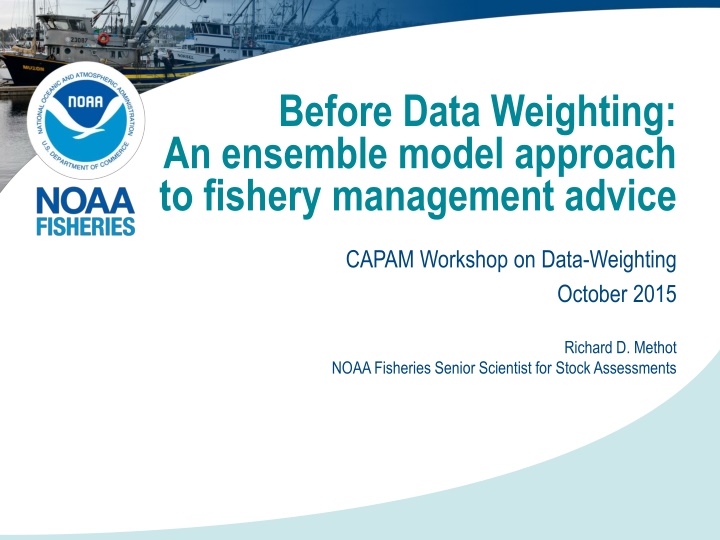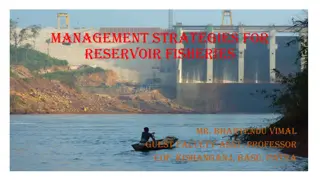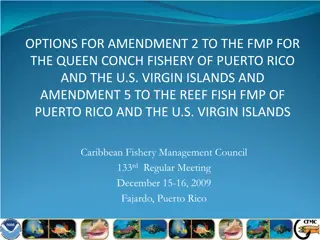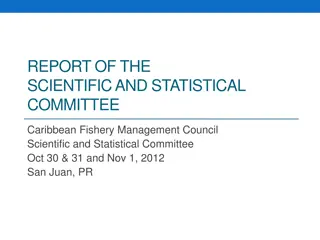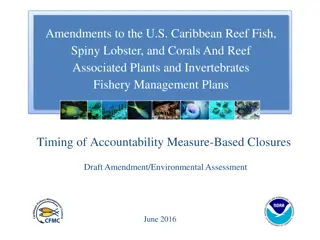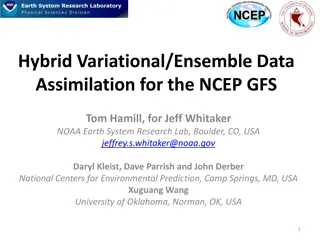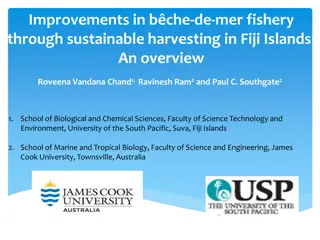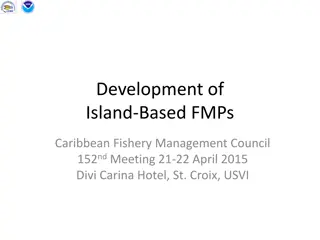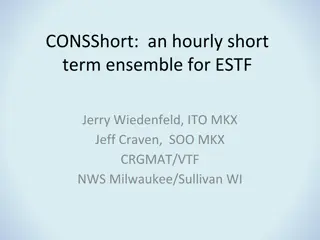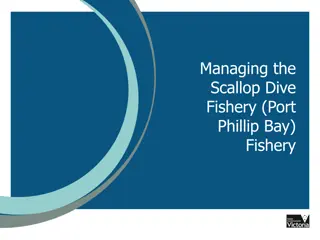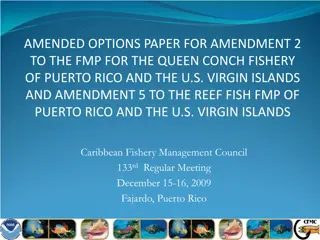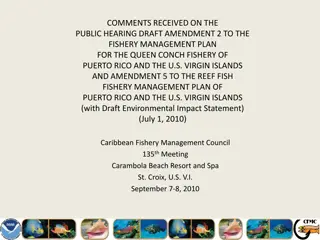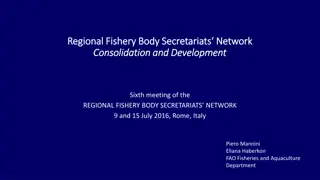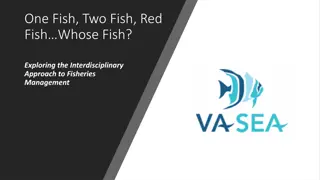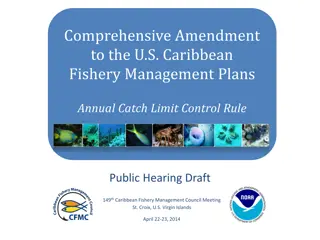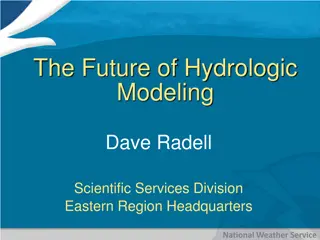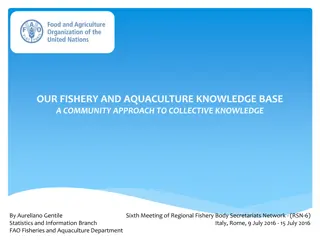Ensemble Modeling in Fishery Management: Insights from CAPAM Workshop
Structural uncertainty dominates fishery management decisions as discussed in the CAPAM workshop on data-weighting. The workshop highlighted the importance of ensemble modeling, protocols for ensemble membership, and communication of ensemble distributions for effective decision-making. Various case studies were presented, including Pacific hake, Petrale sole, Atlantic bluefin tuna, and Southern New England yellowtail flounder. Decision analysis techniques were demonstrated for maximizing gains and minimizing losses in different fishery scenarios, emphasizing the need for robust decision-making frameworks in the face of uncertainty.
Download Presentation

Please find below an Image/Link to download the presentation.
The content on the website is provided AS IS for your information and personal use only. It may not be sold, licensed, or shared on other websites without obtaining consent from the author.If you encounter any issues during the download, it is possible that the publisher has removed the file from their server.
You are allowed to download the files provided on this website for personal or commercial use, subject to the condition that they are used lawfully. All files are the property of their respective owners.
The content on the website is provided AS IS for your information and personal use only. It may not be sold, licensed, or shared on other websites without obtaining consent from the author.
E N D
Presentation Transcript
Before Data Weighting: An ensemble model approach to fishery management advice CAPAM Workshop on Data-Weighting October 2015 Richard D. Methot NOAA Fisheries Senior Scientist for Stock Assessments
Take Home Messages Structural uncertainty dominates Thru sensitivity analyses, decision tables, MCMCs, grid profiles and stuck juries we are close to ensemble modeling today Multiple operating models in MSEs are ensembles A few examples of explicit ensembles exist Protocols for membership in ensembles need development Communication of ensemble distribution, central tendency, decision analysis need development
Structural Uncertainty Dominates Pacific hake 2010 Ralston et al; Meta-analysis 2015 M, h, q estimated U.S. Department of Commerce | National Oceanic and Atmospheric Administration | NOAA Fisheries | Page 3
Decision Analysis Petrale sole States of nature were based on the likelihood profile of female M Midpoints of the lower 25% probability and upper 25% probability regions U.S. Department of Commerce | National Oceanic and Atmospheric Administration | NOAA Fisheries | Page 4
Decision Analysis for Atlantic Bluefin Tuna Maximize the minimum gain vs. Minimize the maximum loss Rosenberg et al. 2012. Scientific Examination of Western Atlantic Bluefin Tuna Stock-Recruit Relationships
Southern New England Yellowtail Flounder Same regime shift question as in Atlantic bluefin tuna Close vote in SSC Chose regime shift, so lowered rebuilding Bmsy, and lowered MSY Regime Shift? U.S. Department of Commerce | National Oceanic and Atmospheric Administration | NOAA Fisheries | Page 6
MSE for southern bluefin tuna Define operating models to incorporate uncertainty about the stock, dynamics and sampling Level of productivity (steepness of SR) Level of natural mortality Interpretation of CPUE Currently an ensemble of 320 models Use to test candidate HCR proposed by member scientists Find HCR that is robust to uncertainties, achieves rebuilding objectives and maintains a viable industry
DLMTool Carruthers et al DLMtool uses Management Strategy Evaluation and parallel computing to make powerful diagnostics accessible Includes over 55 MPs 3 catch-based, static 6 depletion-based, static; e.g. DBSRA 2 catch-based, dynamic 4 depletion-based, dynamic 6 abundance-based, dynamic Same MP functions that are tested by MSE can be applied to provide management recommendations from real data. SUMMARY: Evaluation of model skill using MSE to guide selection for development for management advice U.S. Department of Commerce | National Oceanic and Atmospheric Administration | NOAA Fisheries | Page 8
More pseudo-ensembles MCMC Grid Profile likelihood based search across all parameter space Key parameters (M, h, q) may have informative prior Discontinuous structural decisions possible, but harder, to incorporate Structural uncertainty then could be represented in the LogL based uncertainty calculation Advice is the median of the posterior density function MPD estimate of free parameters given selected grid position Key parameters form the grid dimensions Structural decisions can be a grid dimension Moments of the grid can be unweighted, LogL weighted, weighted by another measure of model skill Advice may not be prescriptive, instead can be the pdf of possible outcomes given possible management decisions U.S. Department of Commerce | National Oceanic and Atmospheric Administration | NOAA Fisheries | Page 9
Approaches to Dealing with Structural Uncertainty Turn into estimated parameter Contrast in a decision analysis Alternative operating models in MSE Expand into an ensemble U.S. Department of Commerce | National Oceanic and Atmospheric Administration | NOAA Fisheries | Page 10
Ensemble Model Approach in Other Fields Burnham and Anderson, 2002. Model Selection and Multimodel Inference Dietterich. 2000. Ensemble methods in machine learning. In Multiple classifier systems Tebaldi and Knutti, 2007. The use of the multi-model ensemble in probabilistic climate projections. Yun et al. 2005. A multi-model superensemble algorithm for seasonal climate prediction Grueber, et al 2011. Multimodel inference in ecology and evolution: challenges and solutions. Thomson et al. 2006. Malaria early warnings based on seasonal climate forecasts from multi-model ensembles U.S. Department of Commerce | National Oceanic and Atmospheric Administration | NOAA Fisheries | Page 11
Super-Ensembles Superensembles use the predictions from multiple models as covariates in a new statistical model Trained against a set of known results Includes correlations among models in the ensemble U.S. Department of Commerce | National Oceanic and Atmospheric Administration | NOAA Fisheries | Page 12
Western Pacific Swordfish Ensemble Model Kolody et al 2008 Multifan-CL 192 models in Most Plausible Ensemble 2 stock recruitment curve steepness priors 2 diffusive mixing assumptions 8 growth rate / maturity / mortality options 2 recruitment deviation options 2 sample size down-weighting options for catch-at-size likelihoods 3 relative weighting options for CPUE 2 selectivity constraint options Data weighting is part of the ensemble structure Parameter estimation error < above structural error U.S. Department of Commerce | National Oceanic and Atmospheric Administration | NOAA Fisheries | Page 13
An aside on composition data Biomass dynamics works by comparing observed B to e( B) from catch and f(B) Composition data improves on biomass dynamics: Explicit selectivity Information on recruitment deviations Composition data competes with biomass dynamics: Direct information on Z rather than on B But now conditional on M, selectivity, and R trend U.S. Department of Commerce | National Oceanic and Atmospheric Administration | NOAA Fisheries | Page 14
Structural Choices / Potential Ensemble Axes FACTOR OPTIONS Q fishery CPUE Q - survey M Growth Selectivity Selectivity Selectivity Spawner-recruitment shape constant, trend, random walk Uniform, or informed prior fixed, or estimated with prior Set, estimated, time-varying asymptotic, or domed; parametric or non time-invariant, or not Size based, age-based, both Bev-Holt, Ricker, Shepard, none, regime- shifted fixed, =1.0, estimated, with prior, inferred Random, env-linked, dev from SRR, auto- correlated Emphasize trend info vs. composition Spawner-recruitment steepness Recruitment deviations Data-weighting A few more U.S. Department of Commerce | National Oceanic and Atmospheric Administration | NOAA Fisheries | Page 15
Ensemble Proposal Define a set of model configurations that is always in the ensemble Allow for at least one stock specific ensemble factor Run all with internal tuning to the extent implemented Classify into tiers of plausibility? Based on? Get catch advice and status projection from each according to standard harvest policy Get status projection from each, given median catch advice from all Report distribution and median as the consensus advice (by plausibility tier?) U.S. Department of Commerce | National Oceanic and Atmospheric Administration | NOAA Fisheries | Page 16
Questions How can we support status determinations and ACL setting from an ensemble of possible results? Ensembles by model configuration within package?, by alternative but similar software?, by different degrees of model complexity? Un-weighted, logL-weighted, other skill weighted, or super-ensemble? How much tuning, data-weighting, random effects estimation should occur within each ensemble member? Can we focus attention on the big picture and avoid getting lost in weeds of ensemble members? U.S. Department of Commerce | National Oceanic and Atmospheric Administration | NOAA Fisheries | Page 17
